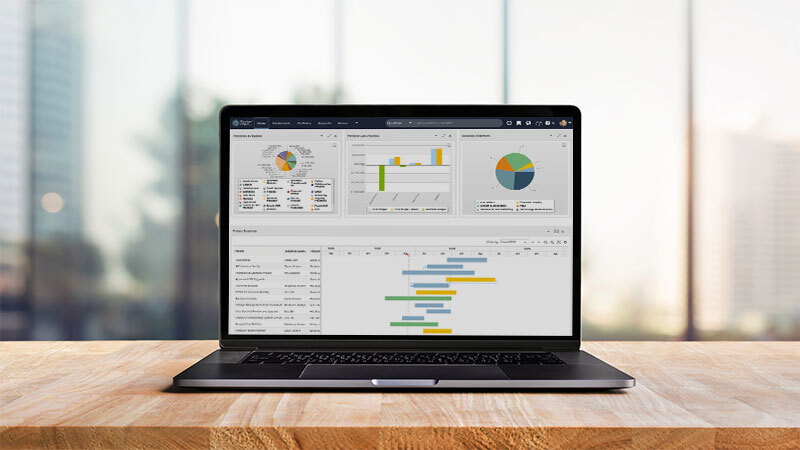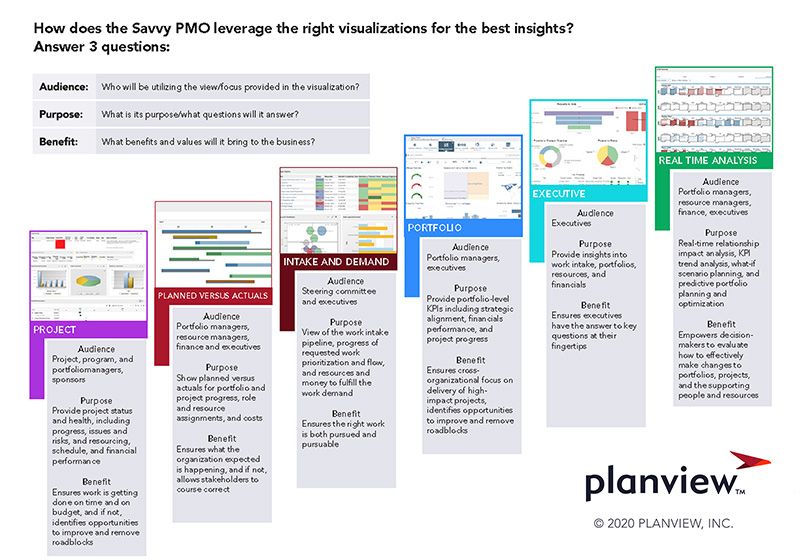
Does your PMO provide the project visibility and insights required to help the organization deliver on strategy? For some PMOs, project visibility is limited to just project status. This two-part blog series outlines how to design our own set of reports, analytics, dashboards, and KPIs to elevate visibility and provide the strategic insights your multiple stakeholders need to make critical decisions.
The Savvy PMO extends visibility and reporting to six key areas:
- Project Status and Health
- Planned versus Actuals
- Intake and Demand
- Portfolio
- Executive
- Real-time Analysis
Success requires the ability to visualize and analyze trends and interdependencies across the business, incorporating data from portfolios, projects, and programs. PMOs must also have insights into work demand, work status, budgets, and resource capacity. Using this information, Savvy PMOs tailor effective visibility and reporting to stakeholders, collaborating with them to make better decisions that create value for the business.
In this post, we cover the first three areas of visibility. Start by identifying the metrics your stakeholders require for decision-making, then build reports, analytics, and dashboards to highlight that data. To leverage the right visualizations for the best insights, answer these questions for each area of visibility:
- Who will be the audience for the visualizations and reports?
- What is the purpose? What are the outcomes?
- What benefits will it bring to the business?
Your visibility and reporting expansion begin with project status and health.
1. Project Visibility: Status and Health
At the project level, it is critical for sponsors and managers (project, program, and portfolio) to have project visibility into overall status and health. Savvy PMOs also include the ability to drill down into the details. These insights facilitate speedy, informed decisions to keep projects on track. Each project status dashboard should have an overall health indicator such as RYG (Red, Yellow, Green), as well as individual ones for the following metrics:
Project Details: Detail relevant project information, such as project title, owner, start date, target date, status, and percent complete.
Financials: Identify and highlight cost and revenue information that stakeholders need. For example, the dashboard could depict budgeted versus estimated costs for labor, non-labor, capitalized, non-capitalized, etc. This data could be shown in phases or another category important to the business.
Project Schedule: Provide an at-a-glance view of project status with Gantt charts. These should include at least the project phase and milestone tasks. Color-coded Gantt bars can indicate overall task health, including project completion percentage.
Issues and Risk: Alert project managers and stakeholders to any obstacles that could impact projects. Present these in list or graphic form showing numbers or priorities. Viewers should have the ability to quickly drill into more details.
Staffing: Display each project team member’s allocations and available capacity. Include list and graphical reports for data such as planned, estimated, and actual hours.
2. Plan Versus Actuals: Visibility to Stay on Track
Knowing the organization’s progress against the plan at any given time is a strategic advantage. Savvy PMOs set up visualizations of planned versus actuals for portfolio and project progress, role and resource usage, and costs. With these insights, portfolio and resource managers, finance professionals, and executives can better deliver on strategic objectives.
Here’s what to include in project and portfolio dashboards:
Portfolio and Project Progress: Give stakeholders a simple view into planned (target) versus actual (completion) so they can see if projects are on schedule or not. A Gantt chart can easily show start, target, and completion dates as well as percent complete.
Roles and Resources: Include planned versus actual role and resource utilization in the project dashboard. Knowing which employees may be under- or over-utilized will help your PMO and other managers optimize resource capacity and determine if additional skills are required.
Costs: Depict budgeted versus actual costs to enable stakeholders to manage costs against budget and across portfolios. These insights also inform future tracking and budgeting. Determine how stakeholders need to track this data over time and slice and dice it (e.g., by project, portfolio, capitalized/non-capitalized, etc.). Trend reports can help stakeholders evaluate against budget to anticipate course corrections.
3. Visibility into Intake and Demand
Determining which work to pursue is a complex process made easier by data-driven visualizations. Savvy PMOs establish an efficient, consistent, and easily understood process for demand management and work intake. Through this process, they provide the insights approvers need to evaluate work requests based on objective criteria and prioritize the ones that will deliver the most business value.
Include these data points in your dashboard to provide a view into work intake and demand management:
Intake Pipeline: Show the work requests currently in the pipeline. Include request titles, current status, requestor, and desired completion date. Enable approvers and decision makers to objectively score and compare requests via criteria such as ROI, strategic fit, complexity, customer impact, and technical risk.
Request Prioritization: Value versus Risk: Provide a visualization of the anticipated business value versus the risk, based on the total request score. This data helps you and your stakeholders do more effective prioritization by determining the real value or benefit of the work and its relative importance to other projects and initiatives.
Role Capacity/Demand: Highlight the available resource capacity versus the requested work demand. This enables stakeholders to understand which work the organization can realistically deliver. You can help them make decisions about reallocating resources or adjusting the requested work.
Portfolio Cost Analysis: Show stakeholders whether or not budget exists to support the requested work. Provide a visualization of the differences between total budget and project spend to date to reveal available budget. Break up these data points by portfolio, strategic objective, or other categories required by the organization.
The ability to create effective visualizations and reporting elevates the PMO as a strategic advisor to the business. This position is strengthened via the last three areas of visibility, which we’ll cover in part 2: visibility for the portfolio, executives, and real-time analysis. For more information about how to become a Savvy PMO, download these eBooks:




![Planview Recognized as a Leader in 2018 Gartner Magic Quadrant for Project Portfolio Management [Infographic]](https://blog.planview.com/wp-content/uploads/2018/06/Gartner-MQ.gif)


